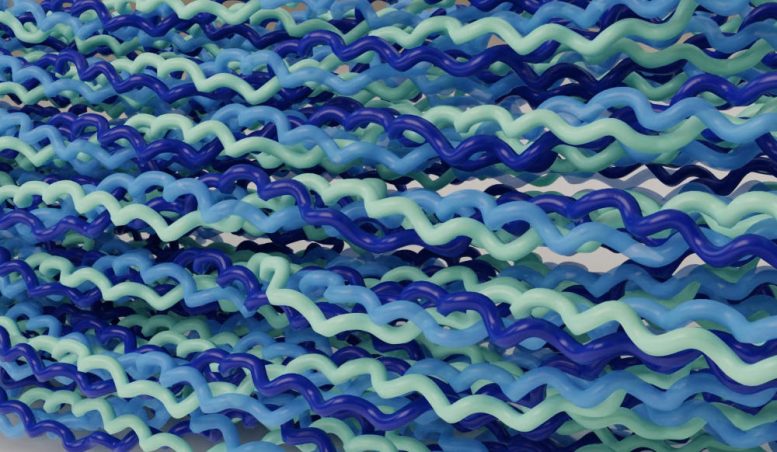
Researchers have found that collagen contains weak bonds that break under stress, protecting the rest of the tissue. This discovery could provide insights into tissue aging and aid the development of tissue engineering techniques. Above is a collagen triple helix. Credit: Riedmiller / HITS
Recent findings about collagen, our body’s most abundant protein, reveal that its sacrificial bonds snap more quickly than the basic structure, thereby protecting the tissue as a whole – they track down harmful radicals that are produced during mechanical stress.
One of the more unusual ways objects can increase longevity is by sacrificing a part of themselves: This can range from decoy burial chambers designed to mislead grave robbers, a fuse deliberately melting within an electrical circuit to protect other appliances, or a lizard’s tail detaching to facilitate its escape.
This concept of sacrificial elements can also be observed in collagen, the most abundant protein in our bodies. Researchers at the Heidelberg Institute for Theoretical Studies (HITS) have revealed how the rupture of weak sacrificial bonds within collagen tissue helps to localize damage caused by excessive force, minimize negative impacts on the wider tissue, and promote recovery.
Published in Nature Communications, the work shines light on collagen’s rupture mechanisms, which is crucial for understanding tissue degradation, material aging, and potentially advancing tissue engineering techniques.
“Collagen’s remarkable crosslink chemistry appears to be perfectly adapted to handling mechanical stress,” says Frauke Gräter, who led the research at HITS. “By using complementary computational and experimental techniques to study collagen in rat tissue, our findings indicate that weak bonds within the crosslinks of collagen have a strong propensity to rupture before other bonds, such as those in the collagen’s backbone. This serves as a protective mechanism, localizes the detrimental chemical and physical effects of radicals caused by ruptures, and likely supports molecular recovery processes.”
Collagen comprises roughly 30 percent of all proteins in the human body. It provides strength to bones, elasticity to skin, protection to organs, flexibility to tendons, aids in blood clotting, and supports the growth of new cells. Structurally, collagen resembles a triple-braided helix: Three chains of amino acids intertwine to form a strong and rigid backbone.
Each collagen fiber contains thousands of individual molecules that are staggered and bound to each other by crosslinks, contributing to collagen’s mechanical stability. It was thought that collagen crosslinks are susceptible to rupture, however little was known about the specific sites of bond ruptures or why ruptures occur where they do.
Scientists from the Molecular Biomechanics Group at HITS aimed to unravel these puzzles using computer simulations of collagen across multiple biological scales and under different mechanical forces. They validated their findings via gel electrophoresis and mass spectrometry experiments conducted on rat tails, flexors, and Achilles’ tendons. By subjecting collagen to rigorous testing, the team was able to determine specific breakage points. They observed how force dissipates through the complex hierarchical structure of the tissue and how its chemical bonds bare the load.
Mature crosslinks in collagen consist of two arms: one of which is weaker than other bonds in collagen tissue. When subjected to excessive force, the weaker arm is typically first to rupture, dissipating the force and localizing detrimental effects. The scientists found that in regions of collagen tissue where weak bonds are present, other bonds – both in the crosslinks and the collagen backbone – are more likely to remain intact, thereby preserving the structural integrity of the collagen tissue.
Previous work led by HITS scientists revealed that excessive mechanical stress on collagen leads to the generation of radicals, which in turn cause damage and oxidative stress in the body.
“Our latest research shows that sacrificial bonds in collagen serve a vital role in maintaining the overall integrity of the material can help to localize the impacts of this mechanical stress that could otherwise have catastrophic consequences for the tissue,” explains Benedikt Rennekamp, the study’s first author. “As collagen is a major substituent of tissues in our bodies, by uncovering and understanding these rupture sites, researchers can gain valuable insights into the mechanics of collagen and potentially develop strategies to enhance its resilience and mitigate damage.”
Reference: “Collagen breaks at weak sacrificial bonds taming its mechanoradicals” by Benedikt Rennekamp, Christoph Karfusehr, Markus Kurth, Aysecan Ünal, Debora Monego, Kai Riedmiller, Ganna Gryn’ova, David M. Hudson and Frauke Gräter, 12 April 2023, Nature Communications.
DOI: 10.1038/s41467-023-37726-z
The study was funded by the H2020 European Research Council and Klaus Tschira Stiftung.

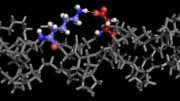
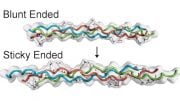

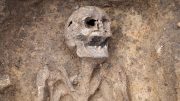
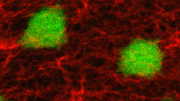


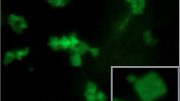
Be the first to comment on "The Sacrifice Within – The Secret Behind Our Body’s Resilience"